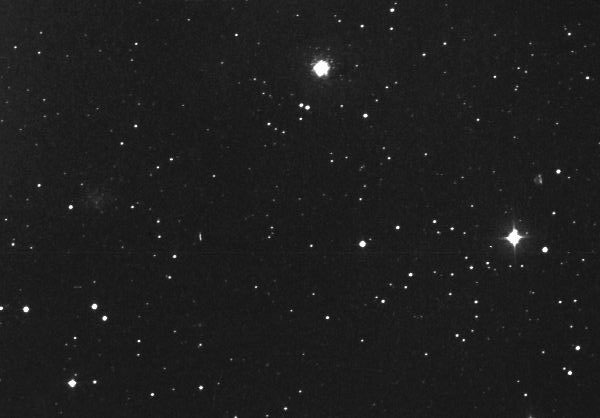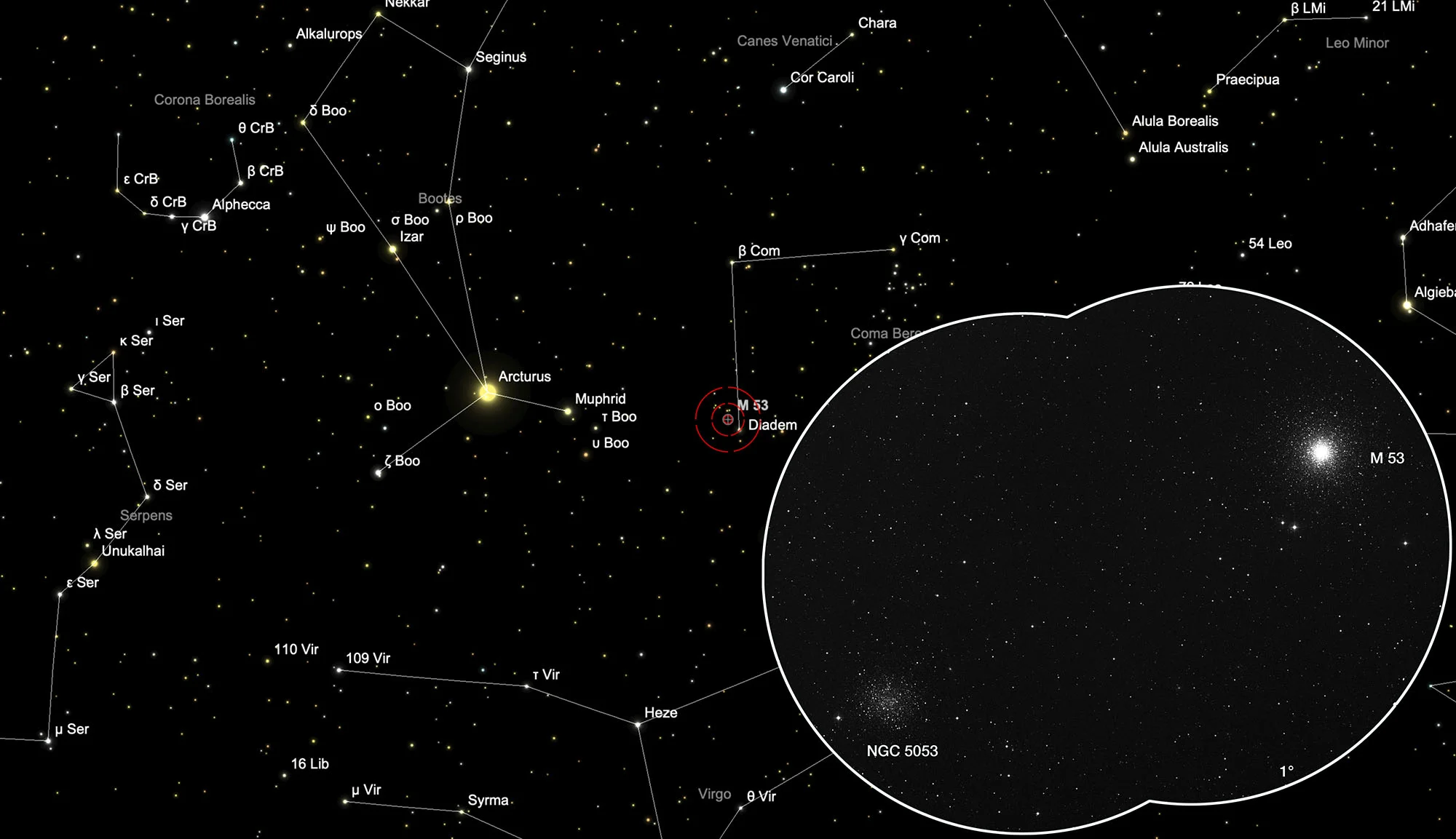Globular Clusters Messier 53 + NGC 5053


Messier 53
In February 1777, Charles Messier made the 53rd entry in his catalog of comet-like objects. Hidden behind the number M 53 is a globular cluster in the constellation Coma Berenices, first mentioned by Bode on 3 February 1775. Bode described him as «round and quite lively» (3 February 1775); Messier wrote almost exactly two years later: «Discovered nebulae without stars in Coma Berenices, a small bit distant of star 42 of this constellation according to Flamsteed notation. Round and conspicuous» (26 February 1777). [4, 281]
The globular cluster NGC 5053 was discovered by William Herschel on 14 March 1784 using his 18.7 inch aperture reflecting telescope. He cataloged it as VI 7 and noted: «An extremely faint cluster of extremely small stars with round nebula 8 or 10' diameter, veryfied at 240x beyond doubt.» [463]
The integrated visual brightness of M53 is about +7.5 mag, the absolute about -8.8 mag, making it as bright as the well-known globular cluster M 13. Due to its distance of 65'000 to 69'000 light years (depending on the source), it appears to us to be significantly weaker than M 13. If M 53 were at the same distance, it would also be visible to the naked eye under good atmospheric conditions. The luminosity of the cluster is around 200'000 times that of our sun.
Although the star cluster appears perfectly round to the observer, it has a slight elongation of 9:10 with a positional angle of the long axis of 170°, which was first observed by Shapley. A pronounced concentration is visible towards the centre. The diameter of M 53 is estimated to be about 55 light years, depending on the assumed distance.
Investigations by Baade, Cuffey, Margoni, and others resulted in a number of around 50 variable stars, including RR-Lyrae stars. The integrated spectral type of the Hercules globular cluster is approximately F4. The brightest stars are 13.8 mag. The average star brightness is 16.9mag. [4]
| Designation | NGC 5024 |
| Type | GCL (V) |
| Right Ascension (J2000.0) | 13h 12m 55.3s |
| Declination (J2000.0) | +18° 10' 11" |
| Diameter | 13 arcmin |
| Visual magnitude | 7.7 mag |
| Metric Distance | 17.900 kpc |
| Dreyer Description | !, globular, B, vC, iR, vvmbM, st 12 |
| Identification, Remarks | h 1558; GC 3453; M 53; GCL 22 |

NGC 5053
About one degree away from M 53 is the globular cluster NGC 5053, which is comparable in size but is about 2.5 size classes fainter. Furthermore, NGC 5053 is by far not as strongly concentrated, but an evenly luminous surface that can only be resolved into single stars with telescopes with a larger aperture (beyond 20 cm). The brightest stars are 14.0 mag bright, but on average 16.6 mag.
NGC 5053 has very few stars for a globular cluster. With a diameter of approx. 100 light years, it contains only approx. 3500 stars - which results in a low density of 0.3 stars per cubic parsec. From studies on variables, a distance of around 55'000 light years was estimated, with a total luminosity that corresponds to 16'000 times that of our sun (remember: M 53 has 200'000 times the luminosity of our sun!). [4]
| Designation | NGC 5053 |
| Type | GCL (XI) |
| Right Ascension (J2000.0) | 13h 16m 27.0s |
| Declination (J2000.0) | +17° 41' 55" |
| Diameter | 10 arcmin |
| Visual magnitude | 9.0 mag |
| Metric Distance | 17.400 kpc |
| Dreyer Description | Cl, vF, pL, iR, vgbM, st 15 |
| Identification, Remarks | WH VI 7; h 1569; GC 3472; GCL 23 |
Finding tip for the two globular clusters
The globular cluster M 53 is almost exactly one degree northeast of the 4.6 mag bright star Diadem (α Comae Berenices), which is easily visible to the naked eye. NGC 5053 is found one and a half degrees east of this star. While M 53 should be easy to find in even the smallest telescopes, even from light-polluted observation sites, NGC 5053 is a problematic object. It is easily visible even at a 114 mm aperture - but this requires excellent transparency of the atmosphere! The following applies to most weather conditions and observation sites: it should be 20cm upwards. To identify NGC 5053, use the close-up of the location card.
Visual Observation
200 mm aperture: M 53 appears as a bright, quite large globular cluster with a clear concentration towards the centre. In this opening, the edge areas are broken up into individual stars. NGC 5053 mostly remains a faintly glowing surface, hardly set against the sky background, which does not show any concentration. In very good conditions this surface looks grainy. — 1997, Frank H. Leiter
